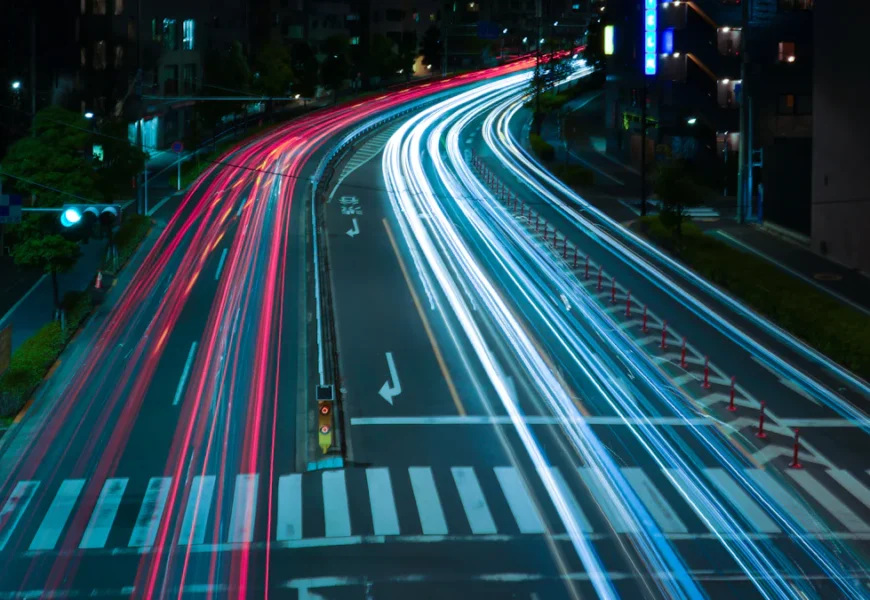Estimated reading time: 9 minutes
Vehicle-to-Everything V2X technology revolutionizes road safety. This advanced system enables vehicles to communicate with each other, infrastructure, and pedestrians. The U.S. Department of Transportation estimates that V2X could reduce unimpaired driver crashes by up to 80%. V2X technology improves safety and reduces greenhouse gas emissions. Continuous advancements in communication technologies enhance V2X effectiveness. Major automakers like Toyota integrate V2X to enhance secure communications. The growing demand for safer roads and efficient traffic flow drives the adoption of V2X technology.
Vehicle-to-everything technology consists of sensors, cameras, and wireless connectivity, such as WiFi, radio frequencies, and LTE and 5G cellular technology, enabling cars to share information with each other, their drivers, and their surroundings.
Understanding Vehicle-to-Everything V2X Communication
Vehicle-to-Everything V2X communication transforms how vehicles interact with their surroundings. This technology enhances safety, mobility, and efficiency. The system reduces environmental impacts by enabling seamless communication between vehicles, infrastructure, and pedestrians. Each type of V2X communication plays a vital role in improving road safety.
Types of Vehicle-to-Everything V2X Communication
Vehicle-to-Vehicle (V2V)
Vehicle-to-vehicle (V2V) communication allows cars to exchange information about speed, location, and direction. This real-time data sharing helps prevent collisions. Drivers receive alerts about potential hazards, such as sudden braking or lane changes. V2V technology eases traffic congestion by optimizing vehicle flow.V2V communications allow vehicles to be continuously aware of each other. When one car brakes suddenly, for example, motorists several yards behind the vehicle could get a safety warning before they get too close.
V2V charging allows the sharing of charge between two EVs, so if an EV is stranded far from a charging station, it can be charged by another EV. Vehicle-to-vehicle charging (V2V) is based on wireless power transfer technology.
Vehicle-to-Infrastructure (V2I)
Vehicle-to-infrastruture (V2I) communication connects vehicles to road infrastructure, such as traffic lights and signs. This interaction improves traffic management by providing drivers with real-time updates on signal changes and road conditions. V2I technology reduces waiting times at intersections and enhances overall traffic flow.
Vehicle-to-Pedestrian (V2P)
Communication between vehicles and pedestrians (V2P) ensures pedestrian safety. Vehicles detect nearby pedestrians and send alerts to drivers. This feature reduces the risk of accidents in busy urban areas. V2P technology enhances pedestrian safety by allowing vehicles to anticipate and respond to human movements.
How Each Type Contributes to Road Safety
Examples of V2V in Action
V2V communication prevents crashes by alerting drivers to potential dangers. For example, when a car suddenly brakes, nearby vehicles receive a warning. This quick response time reduces the likelihood of rear-end collisions. V2V technology also assists in maintaining safe distances between vehicles.
V2I’s Role in Traffic Management
V2I communication plays a crucial role in managing traffic flow. Vehicles receive information about traffic signals and road conditions. This data helps drivers make informed decisions, reducing congestion. V2I technology optimizes traffic signals to improve travel times and decrease fuel consumption.
Enhancing Pedestrian Safety with V2P
V2P communication enhances pedestrian safety by detecting individuals near roadways. Vehicles equipped with V2P technology alert drivers to pedestrians crossing streets. This proactive approach minimizes the risk of accidents. V2P communication creates safer environments for both drivers and pedestrians.
The Technology Behind Vehicle-to-Everything V2X

Vehicle-to-Everything V2X technology relies on several key components to function effectively. These components enable vehicles to communicate with each other, infrastructure, and pedestrians, enhancing road safety and traffic efficiency.
Key Components
Sensors
Sensors play a crucial role in vehicle-to-everything V2X systems. They detect the speed, position, and movement of nearby vehicles and pedestrians. This information helps prevent collisions and improve traffic flow. Sensors gather data that vehicles use to make informed decisions on the road..
Cameras
Cameras provide visual data for Vehicle-to-Everything (V2X) technology. They capture images of the surrounding environment, identifying obstacles and traffic signals. Cameras increase the system’s accuracy by providing real-time visual information. This data supports safer driving and better decision-making.
Wireless Connectivity
Wireless connectivity forms the backbone of Vehicle-to-Everything V2X communication. It enables the exchange of information between vehicles, infrastructure, and pedestrians. Technologies like DSRC and C-V2X facilitate this communication. Wireless connectivity ensures that vehicles receive timely alerts and updates, improving road safety.
Integration of Components
Facilitating Seamless Communication
The integration of sensors, cameras, and wireless connectivity facilitates seamless communication in Vehicle-to-Everything V2X systems. This integration allows vehicles to share critical information quickly and accurately. Seamless communication reduces the risk of accidents and enhances traffic management.
Overcoming Technical Challenges
Implementing Vehicle-to-Everything V2X technology involves overcoming technical challenges. Engineers work to ensure compatibility between different components and systems. Addressing these challenges is essential for achieving reliable and efficient communication. Continuous technological advancements help overcome these obstacles, making the Vehicle-to-Everything V2X more effective.
Vehicle-to-Everything V2X technology represents a significant advancement in road safety and traffic efficiency. By understanding the key components and their integration, you can appreciate how this technology transforms modern transportation.
Benefits of Vehicle-to-Everything V2X Technology
Vehicle-to-Everything V2X technology offers significant advantages for road safety and efficiency. The adoption of this technology leads to safer roads and smoother traffic flow.
Collision Prevention
Real-time Alerts and Warnings
Vehicle-to-Everything V2X technology provides real-time alerts and warnings to drivers. Vehicles equipped with V2X systems communicate with each other to share information about speed, position, and potential hazards. This communication helps drivers respond quickly to sudden changes in rush hour conditions. Real-time alerts reduce the risk of collisions by providing timely information.
Reducing Accident Rates
The implementation of Vehicle-to-Everything V2X technology significantly reduces accident rates. Vehicles on V2X-equipped routes experience fewer crashes compared to those on non-equipped routes. The technology helps maintain safe distances between vehicles and prevents sudden braking incidents. A decrease in accident rates leads to safer roads for everyone.
Improved Traffic Flow
Optimizing Traffic Signals
Vehicle-to-Everything To improve traffic flow, V2X technology optimizes traffic signals. Vehicles communicate with traffic lights to receive updates on signal changes. This communication allows drivers to adjust their speed and approach intersections more efficiently. Optimized traffic signals reduce waiting times and enhance overall traffic management.
Reducing Congestion
The reduction of congestion is another benefit of Vehicle-to-Everything V2X technology. Vehicles equipped with V2X systems travel at speeds closer to the speed limit. This consistency in speed helps prevent bottlenecks and reduce traffic jams. Efficient traffic flow leads to shorter travel times and less frustration for drivers.
Efficient Driving
Fuel Efficiency
Vehicle-to-Everything V2X technology contributes to fuel efficiency. Vehicles use real-time data to optimize routes and avoid congested areas. Efficient driving patterns result in lower fuel consumption and reduced greenhouse gas emissions. Fuel-efficient driving benefits both the environment and drivers’ wallets.
Reducing Travel Time
The reduction of travel time is a key advantage of Vehicle-to-Everything (V2X) technology. Vehicles equipped with V2X systems navigate roads more effectively by avoiding traffic delays. Real-time information allows drivers to choose the fastest routes and reach their destinations sooner. Reduced travel time enhances productivity and convenience for all road users.
Vehicle-to-Everything V2X technology transforms modern transportation by enhancing road safety and efficiency. The benefits of collision prevention, improved traffic flow, and efficient driving make V2X an essential component of future smart transportation systems.
Real-World Applications of Vehicle-to-Everything V2X

Vehicle-to-Everything V2X technology finds practical applications in real-world scenarios. Major automakers and government bodies actively implement V2X systems to enhance road safety and traffic efficiency.
Case Studies
Toyota’s Implementation of V2X
Toyota is at the forefront of vehicle-to-everything V2X technology. The company integrates V2X systems into vehicles to improve road safety. Toyota uses Dedicated Short Range Communications (DSRC) for V2X. This technology allows cars to interact with their surroundings. Vehicles equipped with V2X can prevent accidents by sharing real-time data. Toyota’s commitment to safety drives these innovations. The company sets a benchmark for other automakers in V2X deployment.
General Motors’ V2X Initiatives
General Motors also embraces vehicle-to-everything (V2X) technology. The company focuses on enhancing vehicle communication. GM’s V2X initiatives aim to reduce traffic congestion. Vehicles equipped with V2X receive updates on road conditions. This information helps drivers make informed decisions. General Motors’ efforts contribute to safer and more efficient transportation systems. The company’s initiatives reflect a strong commitment to innovation.
Government Initiatives
U.S. Department of Transportation’s Plans
The U.S. Department of Transportation plays a crucial role in the deployment of vehicle-to-everything (V2X). The department plans to implement V2X nationwide. This initiative aims to improve road safety and reduce traffic fatalities. V2X technology allows vehicles to communicate with infrastructure. The department’s plans include integrating V2X into smart transportation systems. These efforts highlight the importance of V2X in modern transportation.
Global Efforts in V2X Deployment
Global efforts are focused on expanding vehicle-to-everything V2X technology. Countries worldwide recognize the benefits of V2X systems. Governments invest in V2X to enhance road safety. International collaborations promote V2X research and development. These efforts lead to more efficient and safer transportation networks. Global initiatives emphasize the significance of V2X in future mobility solutions.
Vehicle-to-Everything V2X technology continues to transform transportation. Case studies from Toyota and General Motors showcase successful implementations. Government initiatives further support V2X deployment. These real-world applications demonstrate the potential of V2X to revolutionize road safety and efficiency.
Benefits of Software-Defined Vehicles
Software-defined vehicles offer the following benefits:
-
Improved safety is achieved through features such as anti-collision systems and driver assistance.
-
Onboard entertainment systems that integrate connected vehicle features such as music and video streaming provide increased comfort.
-
Deeper insights into vehicle performance through telematics and diagnostics allow for more effective preventative maintenance.
-
The ability for automotive manufacturers to add new features and functionality through over-the-air updates
Vehicle-to-Everything V2X technology will shape future smart transportation systems. V2X enhances road safety, reduces congestion, and supports autonomous vehicles. V2X technology will play a vital role in this transitional period. You should consider the implications of V2X for future mobility. V2X connectivity will improve safety and efficiency by enabling seamless communication. Embrace V2X technology to support safer roads and efficient traffic flow. V2X will transform transportation by integrating vehicles, infrastructure, and pedestrians. As communication technologies advance, V2X technology will continue to evolve.
For more intriguing insights into other STEM-related topics, visit ENTECH Online. Explore our digital magazine dedicated to inspiring teenagers and young adults to pursue their passions in science, technology, engineering, and mathematics.
See Also
- Investment of $1 Billion by Accenture in LearnVantage for Future Skills
- Revealing the Secret Communication of Plants for Improved Crop Yields
- Insights on 3 Important Details Regarding France Fighter Jets Accidents













